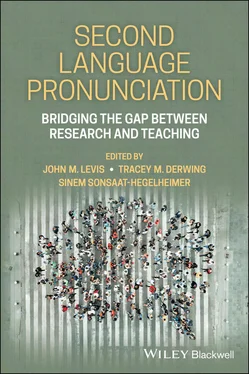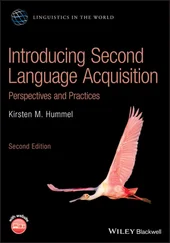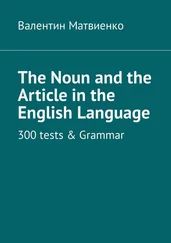Second Language Pronunciation
Здесь есть возможность читать онлайн «Second Language Pronunciation» — ознакомительный отрывок электронной книги совершенно бесплатно, а после прочтения отрывка купить полную версию. В некоторых случаях можно слушать аудио, скачать через торрент в формате fb2 и присутствует краткое содержание. Жанр: unrecognised, на английском языке. Описание произведения, (предисловие) а так же отзывы посетителей доступны на портале библиотеки ЛибКат.
- Название:Second Language Pronunciation
- Автор:
- Жанр:
- Год:неизвестен
- ISBN:нет данных
- Рейтинг книги:5 / 5. Голосов: 1
-
Избранное:Добавить в избранное
- Отзывы:
-
Ваша оценка:
- 100
- 1
- 2
- 3
- 4
- 5
Second Language Pronunciation: краткое содержание, описание и аннотация
Предлагаем к чтению аннотацию, описание, краткое содержание или предисловие (зависит от того, что написал сам автор книги «Second Language Pronunciation»). Если вы не нашли необходимую информацию о книге — напишите в комментариях, мы постараемся отыскать её.
Second Language Pronunciation: Bridging the Gap Between Research and Teaching
Second Language Pronunciation: Bridging the Gap Between Research and Teaching
Second Language Pronunciation — читать онлайн ознакомительный отрывок
Ниже представлен текст книги, разбитый по страницам. Система сохранения места последней прочитанной страницы, позволяет с удобством читать онлайн бесплатно книгу «Second Language Pronunciation», без необходимости каждый раз заново искать на чём Вы остановились. Поставьте закладку, и сможете в любой момент перейти на страницу, на которой закончили чтение.
Интервал:
Закладка:
Table 1.1 Names given to suprasegmentals by different authors.
| Names for Suprasegmental Features | |
|---|---|
| Word Stress | Lexical stress, Syllable stress |
| Thought Groups | Phrasing, Phrase groups, Tone units, Tonality |
| Rhythm | Rhythm (sometimes referred to by duration) |
| Prominence | Nuclear stress, Primary (phrase) stress, Emphatic stress, Sentence stress, Phrase stress, Contrastive stress, Tonic syllable, Pitch accent |
| Intonation | Tune, Contour, Tonicity |
| Other Terms | Tone, Pitch accent (types of word prosody) |
Why Research Findings Should Matter to Teachers
There is a clear need for pronunciation instruction to be guided by empirical evidence. Sometimes intuitions on which teachers rely are wrong. For instance, in a teacher-focused publication, Thompson (2011) suggests that the distinction between English /p/ and /b/ is that the former is produced when exhaling, while the latter is made while inhaling. This latter claim is patently false; English has no ingressive phonemes. As any introductory linguistics textbook will show, these two stops differ in voicing; in addition, in word initial position, aspiration of the /p/ further distinguishes the sounds. It may be that the aspiration caused Thompson and others (e.g., Usher, 1995) to assume that the expulsion of air accompanying /p/ is its only defining feature, and that /b/ must be produced in an opposite way. These “folk” intuitions can have unintentional consequences. Best outcomes for pronunciation students are dependent on the quality of the instruction they receive. Research has shown that ill-informed teachers can actually induce errors in their learners’ speech (Derwing & Munro, 2015; Wang & Munro, 2004). It is thus crucial for language instructors to have a good grasp of the linguistic factors involved in pronunciation in addition to strong pedagogical skills.
The topic of L2 pronunciation, almost forgotten in teacher training programs and language classrooms during the communicative era, has made a dramatic comeback reflected in:
the numbers of new PhDs working on pronunciation topics
the remarkable increase of research being published across a wide range of journals
the establishment of a dedicated journal for the field (Journal of Second Language Pronunciation)
the explosion of professional books looking at various aspects of pronunciation for different languages in the past decade
the extension of pronunciation teaching voices beyond English contexts into other languages, especially Mandarin, Spanish, German and French
the connections of L2 pronunciation across applied linguistics, teaching, computer science and engineering research
extensive research on pronunciation teacher cognition and learner beliefs
the increased attention to new types of technology for pronunciation teaching and learning
the greater visibility of the field reflected in conferences highlighting the research and teaching of L2 pronunciation.
These advances are important, but pedagogy is often still overly influenced by traditional models emphasizing controlled practice such as reading aloud, repeating, and imitating native models. Traditional approaches to teaching pronunciation are typically based on descriptions of sound systems and expert views on challenges faced by L2 learners. They rarely provide evidence that the teaching works (Levis, 2017) or that one approach works better than another. Nor do they explain why certain approaches to teaching work, whether improvement as a result of instruction lasts over time, or whether improvement transfers to untrained contexts.
Nonetheless, as research into L2 pronunciation expands, suggestions for changes to pedagogy are also changing. There is an increasing emphasis on integrating pronunciation with other aspects of language (Derwing et al., 2021; Jones, 2016; Levis & Grant, 2003; Ruivivar & Collins, 2019); on perception training and the increasing use of approaches such as High Variability Phonetic Training (Thomson, 2018); and on approaches that focus on discourse-based rather than word-based and sound-based teaching (Gluhareva & Prieto, 2017; Hardison, 2004; Hirata, 2004). Moreover, we now have evidence regarding the use of task-based pronunciation teaching for pronunciation improvement (Mora & Levkina, 2017); on the primacy of intelligibility and comprehensibility as goals over accentedness (Derwing & Munro, 2015; Levis, 2018); on pronunciation teaching in communicative classrooms (Foote et al., 2016); and on new approaches to teaching pronunciation using technology (O’Brien et al., 2018) and coaching methods (Baker, 2021).
Another issue facing instructors is when to introduce pronunciation, especially since many of the available resources are intended for intermediate or advanced level students. Darcy et al. (2012) suggest that pronunciation instruction should be included “in the first year of extensive exposure to the L2” (p. 94) during the period which Derwing and Munro (2015) have labelled the Window of Maximal Opportunity. Derwing and Munro’s longitudinal study of naturalistic L2 phonological development (in the absence of instruction) indicated that most change happens in the early part of the first year of massive exposure. Thus, it makes sense to capitalize on what Darcy et al. (2012) called the time of greatest pronunciation malleability.
If pronunciation is to be initiated when learners are first intensively exposed to the L2 (as is the case, for instance, with immigrants to a majority English-speaking country), then materials should be available at all levels. Zielinski and Yates (2014) offer sound reasons for implementing pronunciation instruction right from the start, including helping learners with their self-confidence, which, in turn, could lead to increased exposure. Their book of explanations and activities, Give It a Go (Yates & Zielinski, 2009), is freely available and is intended for teachers who have had little or no experience teaching pronunciation: http://www.ameprc.mq.edu.au/__data/assets/pdf_file/0006/276135/interactive_sm.pdf
Intensive instruction at some point, even if it does not continue, also appears to affect future comprehensibility and fluency, suggesting that pronunciation-focused instruction has long-term effects. French et al. (2020) report on an intensive five-month ESL course taken by French L2 learners of English at the beginning of high school with their abilities four years later. Compared to a control group that had not received intensive ESL instruction, the intensive learners had significantly higher ratings of both fluency and comprehensibility. There was no difference with ratings of accentedness.
Although nascent, there are now some studies which probe the success of individual activities on learners’ productions. For instance, Foote and McDonough (2017) examined the efficacy of shadowing recorded dialogues (imitating a model) and found significant improvement. The same learners also produced a picture narrative at three times over an eight-week period, and were subsequently judged by listeners to have improved in both comprehensibility and fluency. The authors attribute these changes to the shadowing activity. More investigations of stand-alone activities such as this will be a benefit to teachers and students alike (see Murphy & Baker, 2015) for a historical review of empirical research in pronunciation teaching).
Pedagogical Implications
Pronunciation teaching and learning includes, like any area of language teaching, a wide variety of activity and exercise types, from minimal pair exercises to discrimination listening exercises, to guided and communicative exercises. How do we know which activities are best suited to promote improvement, and what kind of improvement they promote? It is largely left up to the instructor to determine which ones will work best for their students’ particular needs, taking into consideration not only the type and severity of their problems, but also their age, the nature of the course, their prior education levels, and other aspects of the context. Some activities are relatively simple, while others are complex and require considerable preparation. Here is where research can help the teacher in making choices. In the next section, we address some empirically tested activities that are rarely found in pronunciation texts but which have been shown to have positive results. We have included only suprasegmental activities focused on global speaking and listening skills, in light of the fact that a broad range of segmental resources are more widely available.
Читать дальшеИнтервал:
Закладка:
Похожие книги на «Second Language Pronunciation»
Представляем Вашему вниманию похожие книги на «Second Language Pronunciation» списком для выбора. Мы отобрали схожую по названию и смыслу литературу в надежде предоставить читателям больше вариантов отыскать новые, интересные, ещё непрочитанные произведения.
Обсуждение, отзывы о книге «Second Language Pronunciation» и просто собственные мнения читателей. Оставьте ваши комментарии, напишите, что Вы думаете о произведении, его смысле или главных героях. Укажите что конкретно понравилось, а что нет, и почему Вы так считаете.












